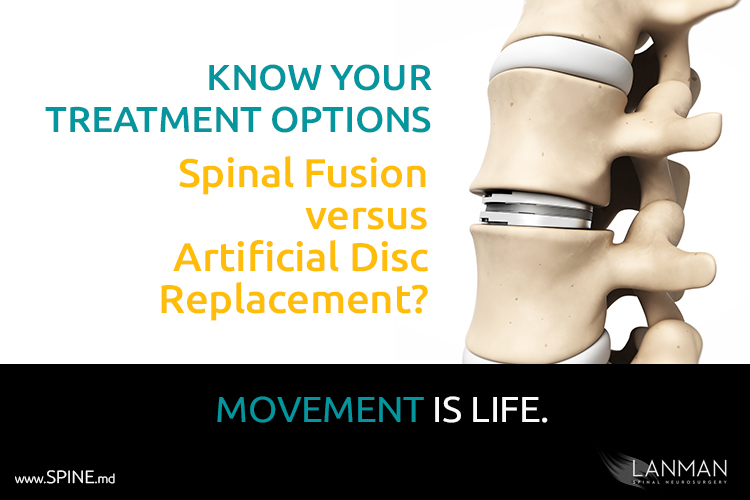Know the facts: Spinal Fusion versus Artificial Disc Replacement?
A neurosurgeon has already diagnosed you with degenerative disc disease resulting from a “slipped” or a herniated (ruptured) disc. You don’t remember how you got your injury – it could have started from any impact you received 20 years ago or an accident you had a year ago. Either way, you suffer from chronic neck or back pain (or both), and you likely have the accompanying radiculopathy (numbness or tingling) or sciatica (pain) in your arms and legs.
You may have already had physical therapy. If you were my patient, I would also recommend a nonsurgical program that includes fitness, nutrition, disease screening, and supplements with a little pain management. You may have had a microdiscectomy or endoscopic discectomy; an outpatient surgical procedure where your doctor removes a small portion of bone and disc material to relieve the nerve from “pinching” that could be a direct result of the rupture. Now you’re weighing your surgical options.
At this point, you’ve probably heard of one of two procedures, or maybe both: artificial disc replacement surgery or spinal fusion surgery.
The two surgical procedures solve the same problem: decrease or stop pain caused by a herniated disc, a facet joint, compressed nerve, or all three. However, the two procedures come from opposite sides when it comes to meeting my primary goal for all my patients, that of preserving as much natural movement of the spine as possible.
Based on my experience from my practice in Beverly Hills, CA, and patients I see at the Cedar-Sinai Medical Center in Los Angeles, I have concluded that spinal fusion surgery is a last-resort solution – when no other solution is viable for the particular patient situation. By its very nature, spinal fusion is a form of brute force against back or neck pain. It stops pain by preventing all movement of the vertebral segment where the pain originates.
The most common way to achieve spinal fusion involves removal of the herniated disc and making a graft of synthetic or actual bone material that the surgeon inserts into the space between the two vertebrae. The goal is to grow enough bone between the two flexible vertebral segments so that the bones fuse together. Where there were once two bones in a flexible segment, the patient ends up with one immobile bony segment. And that’s my biggest problem with the procedure.
With spinal fusion, the patient loses a significant amount of flexibility at the treatment location; they acquire a stiffened posture that requires that they make larger movement in the remaining flexible segments. This is where additional pressure is applied to levels above and below the fusion. Several studies have shown that patients become vulnerable to further degradation of adjacent discs, resulting in the need for additional fusions.
Artificial disc replacement (ADR) surgery received FDA approval in 2005 for lumbar (lower back) procedures and 2007 for the cervical (neck). Since receiving FDA approval, clinical studies have shown a clear advantage in terms of patient outcomes over spinal fusion.
An artificial disc is designed to take over the form and function of the original disc. Many consist of a medical-grade metal (e.g., titanium, chrome). Some are a combination of metal and a semi-flexible synthetic biopolymer. The surgical procedure is straightforward: after the damaged disc is removed (discectomy), the surgeon inserts the artificial disc.
ADR is unlike fusion because the main goal is to help the patient preserve as much natural movement of the spine as possible. Add to this, several clinical studies have shown patient outcomes – specifically, eliminating the original pain generator caused by a damaged or degenerating disc – are best for artificial disc patients than patients who underwent fusion.
It’s important to note that while artificial disc replacement surgery is comparatively new (spinal fusion has been around for more than 70 years), ADR is gaining acceptance by physicians and insurers alike. The reason for this change of mind is because clinical results clearly favor disc replacement.
Ideal candidates for artificial disc replacement include people who are exhibiting varying degrees of degeneration or herniation of a disc and are experiencing chronic and persistent pain and numbness. Occasionally, I will have a patient who has small cracks or fractures in the vertebrae or they may have arthritis in the facet joints. In these cases, spinal fusion surgery is probably the best option. However, I will rely on diagnostic tools like an MRI and CT scan to help me make my final determination. In most cases however, whenever surgery is ultimately determined, artificial disc replacement will be my normal position.
One final note. If you currently experience chronic and persistent pain along your spine and you have suffered from growing numbness or shooting pain in your extremities, the sooner you visit your doctor for a diagnosis, the more treatment options you will have.
Celebrate your health and wellness with MOVEMENT!
###







